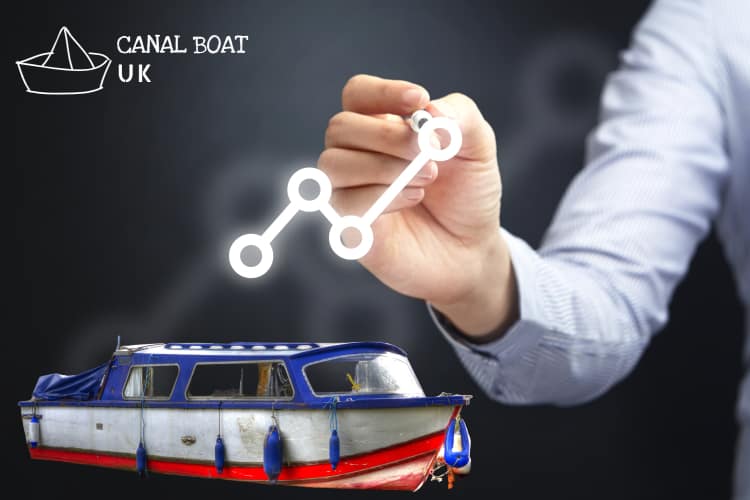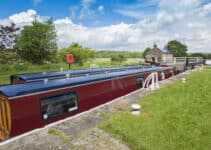Welcome back to Canal Boat UK, and another article that will hopefully shed some more light on the world of canal boats. Today we are trying something totally new, a research project that I have undertaken to try and find some interesting trends within the narrowboat/ canal boat market.
When starting this website, I didn’t just want to share tips and advice around narrowboats, I have the aim to become a valuable member of this community. I don’t see a lot of other people using data to offer insights into narrowboat trends, so this is somewhere I thought I could step in and offer assistance.
Although I am not a statistician by any stretch of the imagination, so I would very much appreciate your feedback here. Was the information shared here useful? Are there specific narrowboating questions that you think I could answer next time? This would really help me going forward, as I plan to do this research project every year.
Before we start, there is one glaring issue that I am already aware of. With all of the data I collected, I missed out one vital piece – narrowboat prices! This was a pretty big mistake on my part and I will make sure to include price data when I do this again. I wanted to mention this as I know otherwise I will get a lot of comments reminding me of this slip up 🙂 No-one is perfect, right? ha ha!
I do have other articles on how much a narrowboat costs and whether narrowboats hold their value, if that helps.
With all that said and done, I hope you find what follows helpful or at least interesting 🙂
What is This Narrowboat Research Project?
When setting out on this research project, I was trying to think of the best place to come up with a large amount of information on canal boats in one place. This is tough, as there aren’t really a lot of places to officially record such data.
Then it dawned on me, I should use Apollo Duck. For those of you living under a rock, Apollo duck is probably the number one place that UK canal boaters like to try and post their boats on for sale. And a lot of these adverts describe their boats in detail, giving me a decent set of data to work with.
Just to be clear, this is not officially associated with or sanctioned by Apollo Duck, I just used the narrowboat data they have available to the public as the basis of my research data. When I started this project, Apollo duck had almost 600 adverts for me to extract information from. This will give me a pool of data from almost 600 canal boats to work with.
It may not be the best dataset ever, but it will certainly give us a decent cross section of the narrowboat community to work with. I am confident any trends we find here should be decently accurate 🙂
If you have a better idea as to where I can get my data for next year’s project, please let me know in the comments section below.
So, what did we actually find out about canal boats……?
What Types of Canal Boats are Most Popular on UK Canals?
We start with something easy, and honestly something most people can work out by spending an afternoon or two on the canals. Having said all of that, it is good to get some hard data about this! See the table below for the makeup of boats we found within all those Apollo Duck listings.

A few notes on the data itself first. When you see the category ‘cruiser’ and ‘motor’, these both refer to different types of river cruisers, so I will combine them to get one percentage for everything I consider a river cruiser. Also, to get the figure for all narrowboats, I will be including the ‘semi-trad’ and ‘trad’ categories in the figure. I am sure you can appreciate it can be hard extracting data from Apollo Duck, as not everyone describes the same boats in the same ways 🙂
When all is said and done, it is clear that narrowboats are by far the most common boats on the canals, not much of a surprise there really. With all narrowboat categories added up, we are talking around 63% of the boats in this study!
Next up is the river cruiser/ canal cruiser, with a combined total of around 21%. I suppose the only slight shock to me was the fact that wide beam boats (in the narrowboat style) only made up just under 11% of the total.
People are Buying Longer Canal Boats
The chart below was a really interesting one. I think we can ignore the first part of the chart, in the 1800s, as we didn’t have enough boats of this age in the data set to get a proper reading. Other than that, the rest of the chart tells an interesting story. As the years have gone by people have been buying ever longer canal boats. I suppose this is not exactly a shocking revelation, but it is good to see in the data all the same.
Of course, you could argue that the data is not totally reliable, as it relies on what boats are up for sale at any one time. This will be biased towards the newer boats as more of the older ones are already in the narrowboat graveyard in the sky! However, I still feel this general trend is a valid one. Any actual statisticians out there feel free to correct me 🙂

It is interesting to look at this data on boat length in different ways. Below is a scatter graph of each boat length physically marked on by year. You can then see clusters of popular length choices. It seems that around the 60 foot mark has been consistently popular for most of the time this data covers.

How Many Berths are There on a Typical Canal Boat?
The other component of the chart above (not the scatter graph) is the average number of berths on canal boats over the years. This has remained remarkably stable right from the off. This is marked by the blue line on the chart.
Even if you try to dive deeper into the trends of the average berths by year on its own, we still don’t see any major ongoing trends. Again, you can ignore the first part of the chart, but even after that I don’t see a consistent trend. It is gradually going up, but not by much and not in a consistent way. I would take a guess that the end of the chart can also be disregarded as not many people are selling their brand new boats on Apollo Duck just yet 🙂

If you have ever wondered what number of berths has been most popular over the years on canal boats, this next chart answers that very question. It is clear to me from the chart below, that 2, 4 and 6 berths are most commonly used, with the lower end of that scale being more popular.

This increase of canal boat berths and lengths over time is also backed up by these Pearson correlation calculations.
Correlation analysis of Canal Boat Berths and Length over the Years.
The table below shows Pearson correlation among year, berth and length of boats. The results indicate that year is positively and significantly correlated with berth and length. In other words, as year increases, berth and length are also increased.

Which Engine is Most Popular on Narrowboats and Canal Boats?
If you read my article on engines for narrowboats, you will know that I talk about the advantage of having a popular engine. If you look at the chart below, you can see that the most popular engine is the Beta Marine, so you know if you have a break down or problem, you will probably have someone around you with the same engine. Spare parts will also be generally easier to find and cheaper on engines that are more popular and widely available.

Well that concludes this research project experiment for this year. As you can probably tell, I don’t attempt things like this very often. Although this year the data was far from perfect, I hope you all found our something interesting about narrowboats and canal boats today 🙂
As I said above, please give me your feedback about how useful this was and any ideas you may have for how to improve it next time.
Happy boating!



![What Happened to Cruising The Cut [Narrowboat Youtuber]](https://canalboatuk.com/wp-content/uploads/2022/08/cruising-the-cut-youtube-channel-211x150.png)
